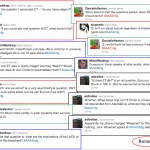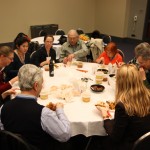On Saturday, I did something I swore I would never do.
I opened a Twitter account.
Until then, I’d managed to avoid Twitter. It annoyed me. Its over-exposed ubiquity made me want to don a Twitter-stealth-shield that would deflect any and all references to the site and ensure a blissfully Twitter-free day. I wondered why ‘tweets’ were so named, why reputable organizations…and people like our President…were linking themselves to a <140-character social networking site, and why the amount of ‘followers’ Ashton Kutcher had was considered “news.”
But then I figured that because I’d already jumped in, I may as well see how deep I could dive. Now I’m one of Ashton’s 5,885,514 followers – as of 10pm Sunday, October 3, that is. That number is probably higher already, and I’m more than swimming in Twitter’s Kool-Aid – I’m drinking it. I can’t wait for my first AplusK Twitter-tweet…
…and I’m liking it. It’s overwhelming, but I’m following many kick-ass journalists and science organizations and enjoying the effect of all that collective brainpower. Twitter is more than social-networking – it’s instant information-sharing. Or it can be. I still don’t know how things work – what are these funny graphics, and why does everyone have an @ in front of their names? It messes with the reader in my head. But whatever. at-Slugnads is having fun.







I too had held out as long as possible, trying not to get sucked in. Now that I’ve fallen off the wagon, I’m still not sure how I feel. It’s overwhelming, but I agree that it’s fascinating to think about a collective information feed.
I joined in February, but had no idea how to use Twitter. It’s a lot more useful now that I’m following mostly science journalists, and getting links and news from it. It’s still overwhelming in its vastness and immediacy, but I’m learning how to wade into the sea of information.
I agree, the tuned-in scientists and journalists I’m following now make for a much better Twitter feed. I do wish some rules could bend– pounds signs and commercial at symbols make my eyes cross and since most people have moved beyond SMS for Twitter access, why do we need to stick to the 140 character rule?
On drinking the Kool-Aid (verified AP-style), would Jim Jones have tweeted?
OK, extraordinarily insensitive, but tied to a serious concern.
I’m wary of the sound bite and Twitter seems structured to promote nothing but sound bites. A psychological critique of the media I first heard from Noam Chomsky argues that the speed, brevity, and repetitiveness of information that makes it into the mass media mix ensures that only conventional thoughts can be transmitted.
Twitter thus seems well-suited to amplify ideas that reinforce the status quo, stereotypes, and problematic “common knowledge.” Why would we want to use a tool of mass communication in our own hands to mimic the potentially ignorance-inducing practices of the “old” news media?
Here’s Micheal Hirschorn, a contributing editor to the Atlantic, in a chat with Techcrunch on why social media is evil and Americans will believe anything online.
Dude. You left a word out.
I’d like to think I tastefully paraphrased…besides, I would feel bad stealing Techcrunch’s thunder.
You are a nicer man than I.
Love, snark-nads
I think that’s an excellent point, and one to keep in mind when using not just Twitter, but any form of media. I certainly complain enough about the mass media’s ability to convert nuanced arguments into sound bites.
But when it comes to Twitter, is it fair to blame the medium? I think it’s up to us to tweet or blog responsibly– to not uncritically spread common knowledge or reinforce stereotypes; to not give up accuracy for speed.
No matter the medium, journalism can be good or bad, and I don’t think we can blame the tools just because they may make it easier for us to be lazy or careless in what we say, or in repeating what others say.
That’s not to say there aren’t a lot of inane tweets and pointless blogs. Particularly with new media, there’s just a lot of information out there. But it’s up to us to sift through it critically, and figure out what the News is. And then do our best to use those same tools to spread it.
I also think new media actually has some strengths over traditional media when it comes to dealing with sound bites:
1. The media usually plucks a sound bite out of a longer speech or statement by a person. But if that person is on Twitter or has a personal blog, you can actually get their direct, unfiltered statements, without relying on someone else to report it. And you can spread that information faster as well, without relying on traditional media.
2. Also, when you tweet or blog, you don’t have to just present facts from up high. You can post links to primary information and sources, or to more detailed articles on a subject. Your specific tweet can be just a way to capture someone’s interest, and get them to dive into the subject more deeply.
3. Most importantly, other people can reply (Or comment, as we’re doing here…) much more easily and transparently than with traditional media. As an author, you can directly hear people’s arguments, and respond accordingly.
I’m still just wading into the whole social media and Twitter world, and I think there’s good reason to have concerns. But at the same time, I do think there’s a lot of potential as well.
I think we’ll just have to keep an open mind as we figure out how best to use Twitter and new media. I certainly don’t think we’re the only ones in that position.
What do you guys think about Rhett Butler’s comment today that his Twitter feed — though well-populated with followers — generates very few click-throughs? Are Mongabay’s tweets a casualty of the ‘sound bite’ or too far out in left field (ha) to interest followers? It seems bizarre that 45000 followers could be so passive.
I thought Rhett’s comments were really surprising. I don’t know if that’s an indication that a website’s twitter feed generates less interaction than an individual’s?
The reason I found it surprising is that just a couple of days ago I saw this report comparing different forms of social media.
The report was by a marketing firm, SocialTwist, and found that Twitter dominated in terms of click-throughs.
Twitter yielded an average of 19.04 clicks, compared to Facebook’s 2.87 clicks. That’s despite the fact that Facebook was the preferred choice for sharing, with 78% of people using it, and only 5% using Twitter.
I don’t know if that just means that those who’ve figured out how best to use Twitter get a ton of click-throughs, while most others don’t benefit much, if at all.
And to put all social media in perspective, in terms of total referrals it was good ol’ email that did best, accounting of 55% of all referrals (Social media accounted for 24%, and IM for 18%). Best to keep that in mind, although their data does show social media growing rapidly.
I wonder if the website feeds feel too impersonal for people to want to interact with? I know my eyes tend to glaze over tweets from some of the bigger organizations I follow.
To anecdotally counter that point, however, I find facebook more ‘personal’ than twitter — photos, commenting, notes, whatever — yet the data above clearly suggest that twitter generates more click-throughs than fbook.
But it seems as though a site like mongabay — and their 2million monthly viewers, and friendly topic — should have a built-in following of people who tend more toward the activist side of the spectrum.
wow that was poorly-phrased.